Tag archives for: architects

Congratulations on your recent graduation.
It probably feels pretty amazing to have that degree.
Of course, the longer you go without using it, the more that degree is going to become an irritating reminder. So, let’s look at four of the best architecture careers you can start pursuing right away.
The 4 Best Architecture Related Careers to Get Started in Right Now
The field of architecture is at least as broad as it is old. As such, it’s probably fair to say that there are countless architecture careers out there for you to consider.
However, the following four fields will give you plenty of diverse options beyond the traditional versions. Best of all, each features plenty of job openings throughout the country.
- Landscape Architect
Landscape architects are responsible for planning and creating landscapes, which can include manmade features, as well. Oftentimes, landscape architects need to collaborate with others, so that their creations complement buildings that will share the same environment (and vice versa).
This career may also involve the long-term care of the landscape, as well. This is when a talent for the natural sciences is very helpful.
- Urban Planner
While urban planners and architects are not the same thing, the former relies on the latter. In fact, many architects make a career out of leveraging their skills specifically to help with urban planning.
As a huge part of this field involves the buildings in urban environments, it requires an architect who’s able to take the resources available (including money and space) and make the most of them. An architect who becomes proficient at this will never be long without work.
- Architecture Journalist
Architecture is such a massive industry that it requires an equally impressive army of journalists. Unfortunately, most journalists don’t have a very good understanding of architecture. They might be able to cover the topic for those outside the industry, but their lack of knowledge wouldn’t go unnoticed by those who depend on a high-level expertise for a living.
If you understand everything from the vocabulary unique to architects to its history and current trends, you’ll be a priceless asset as a journalist for this industry.
- Architectural Historian
Finally, if you have a passion for history and architecture, you will be uniquely qualified to become an architectural historian.
In short, as an architectural historian, your job will involve advising restoration projects aimed at buildings of historical significance. This often involves researching the building to better understand the materials and methods that were used to build it.
Want an Expert’s Help Considering Architecture Careers?
While we hope that the above list of possible architecture careers is helpful, we know that this decision is a big one and you may want some help with it.
At Consulting For Architects, Inc. Careers we’ve helped recent graduates just like you with this important next step, ensuring that they find jobs which fall in line with their interests and career goals. Contact us today at (212) 532-4360 or [email protected] to learn more about how we can help you do the exact same thing.
Job Search Mobil App
Enter for a chance to win an iPhone 8!

Green means green for architects that make a serious investment in green architecture and sustainability. When the recession hit in 2007, the housing and real estate markets were hugely impacted. Jobs in architecture became scarce, and architects started getting laid off in droves. Though there’s been an increase since 2010 in positions in this arena, the sector still struggles to maintain a steady increase in available gigs. According to SimplyHired, since July of 2013, there’s been a 24.4% increase in employment in Los Angeles and 34.4% in New York, so things are looking brighter. In fact, the green or sustainable architect is experiencing a major increase in work, with positions in both cities at an all time high because of the growth of the green economy.
There’s really no set rule for who can dub themselves green architects, but the program responsible for verifying green buildings is LEED (Leadership in Energy and Environmental Design). It gives points to projects based on their utilization of sustainable components. However, LEED doesn’t give awards to projects for performance, so there are other available options for certification: the Living Buildings Challenge, Passive House Institute, Green Globes and the government’s Energy Star Program all provide certification based on green standards.
In major metropolises like New York and Los Angeles, the green economy is growing. The public’s demand for green construction is due to its growing awareness of the dangers of climate change. While the green movement is considered “chic,” architects are expanding their views by combating climate change not only with their building designs but by constructing the bigger systems in which they function.
“We think of great design as having four equally important parts: ethical practice, experiential design, thoughtful impact, and excellent delivery. Included in ethical practice is sustainability and the idea that you can’t create great design without it. This translates into our everyday office operations in many big and small ways. The really exciting sustainable operations are yet to come in our new office!”
Irwin Miller, Los Angeles, Principal Design Director, Gensler .
In 2011, the BLS (Bureau of Labor Statistics) listed the mean wage for a green architect as $83,390 – about $30,000 more than a residential architect. The BLS also predicts faster-than-average growth for architects until 2020, with green architects in particularly high demand.
Architecture is about designing structures. Green architecture goes one step further by altering structures so that they can contribute to the well-being of the environment. Some architecture firms are green firms not only because they specialize in this type of building, but because they incorporate the green philosophy into how they operate.
Green Architecture Sites:
Inhabitat
Architecture for Humanity
BLD BLOG
Green Architecture
|
#architecturejobs, architects, architecture, Architecture for Humanity, BLD BLOG, buildings, climate change, economy, Employment, environment, Gensler, Green, Inhabittat, jobs, LEED, LEED Gold Certification, Reccession, SimplyHired, sustainability
|
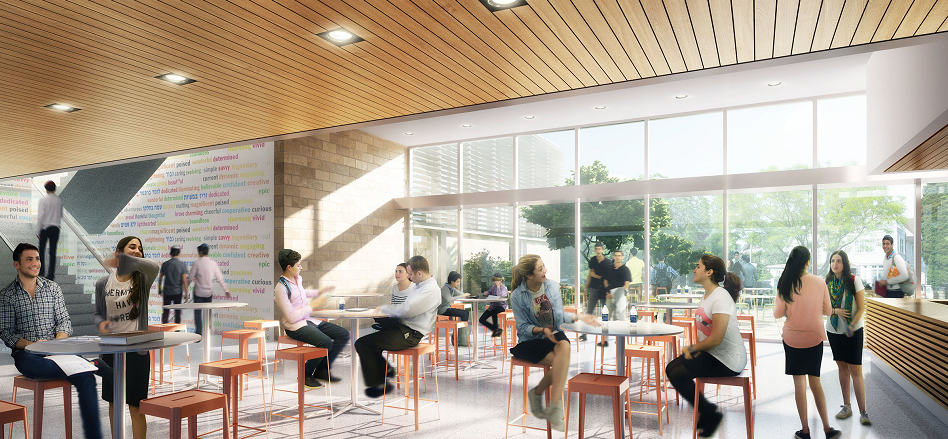
Hiring Millennials
Baby boomers are retiring in record numbers, and their millennial replacements are very different in terms of personal characteristics, as well as job and workplace expectations. Millennials, aged 18 to 34 years old, already makeup more than one-third of the workforce. By 2025, they will account for close to 75 percent. Architecture firms are now in an intense competition to attract and retain qualified millennial professionals. Understanding the millennial perspective and developing a suitable workplace environment are imperatives for business sustainability.
Characteristics of Millennials
Millennials are one of the most analyzed generations because of their complexity. They are the first generation of digital natives, and technology has enormously influenced their expectations. For example, they are driven by a need for social connectedness and have integrated technology deeply into their personal lives. As such, they now expect the same in their work lives. CISCO calls it the “new workplace currency,” since 56 percent of college students surveyed said they would not accept a position at a company that banned access to social media.
Millennials have high expectations. They want higher pay based on skills sets and faster promotions. They believe the firm should provide appropriate leadership development and have values that match their own. If the business fails to meet these expectations, the employee will leave. Millennials are not interested in plugging along doing eight hours of mundane routine work they see as having little social impact. They want to do meaningful work that is clearly connected to solving complex societal problems.
Millennials are optimistic about the future and are a diverse generation, with over 44 percent identifying with an ethnic group or a minority race, according to theU.S. Census Bureau. They are content creators, thriving on collaboration. They also want work-life balance, which for the millennial may mean using remote-work technology. A 2015 CISCO survey found that over half of Gen Y (millennials) and Gen X (generation sandwiched between baby boomers and millennials) consider themselves accessible for work 24/7.
Perhaps the most important characteristic to understand is that millennials want to work for companies that reflect their personal values. A Deloitte survey found that 56 percent of millennials had ruled out working for an employer because their values were in conflict. This is perhaps one of the most difficult concepts for traditional organizations to master.
Why are You Leaving?
Understanding the top reasons millennials change jobs provides a knowledgeable foundation for developing recruiting and retention strategies. Consulting for Architects, Inc. (CFA) conducted a survey which asked architecture and design firms to rank, in descending order of importance, the reasons employees aged 18 to 35 years old left their firms. The results are revealing and support much of the academic and business research and studies conducted over the years to identify millennial characteristics.
Ranking number one in the CFA survey as the top reason for millennial turnover is concern about the lack of opportunities for career advancement. Number two is a desire for more challenging work. Number three is dissatisfaction with the leadership of senior management. Number four is disagreement with the overall direction of the organization. Number five is dissatisfaction with the compensation and benefits. Number six is unhappiness with the amount and/or type of rewards and level of recognition for contributions to the firm. Number seven is a desire to seek a better work/life balance.
It is not surprising the leadership of senior management ranks high because these are the people most responsible for the firm policies and procedures, business culture, and talent management system. Since many of the senior leaders are baby boomers, there is a generational difference in attitudes towards work, career, and the need for employee recognition. Baby boomer architects and designers spent many years doing low-level assignments, putting in many hours without regard for work/life balance. The rewards were the work itself and steady career advancement, and for some, reaching a point where it was possible to start a new business. Now baby boomers are managing organizations in which millennials already comprise or will soon comprise most of the workforce, and the younger generation wants change.
A good example of the generational difference is found in a blog written by a millennial architect. The title says it all – “Millennial Architect Won’t be Your CAD Monkey.” There have been other surveys conducted, and they support the CFA survey results and the need for senior leaders to adapt the work environment to meet the needs of the millennials. A 2012 survey, for example, found that millennials expected to stay in their jobs for less than five years.
Recruiting Millennials
The strategies for attracting and recruiting millennials specifically address their characteristics and the top reasons they leave architecture firms . First, it is important to develop a workplace culture that nurtures the millennial spirit and makes young architects believe this would be the best place to work. The culture must embrace diversity and cherish the organization’s brand and reputation. For instance, since millennials always check social networks for information, potential employers should take into consideration what current employees, clients and communities are saying about the company. Every architectural firm should regularly monitor and manage the online conversation concerning the organization. The online conversation coupled with the marketing strategies needs to demonstrate the architecture firm’s mission, values, ethics and beliefs, so that recruits will see that their personal values align with the organization’s values.
Technology plays a critical role in other respects. Video interviews can showcase an architecture firm as a progressive and flexible culture, and can often provide distinct advantages to both the firm and the interviewee. For the millennial, video interviews are also more convenient, as they get an opportunity to show their true character instead of only what is on the resume.
For the architecture firm, video interviewing saves time and money because the cost is much less compared to in-person interviews. It makes the hiring process quicker while also giving the interviewer an opportunity to explore facets of the person’s personality traits, something not possible with a written resume. Overall, video interviewing fits a modern workforce expecting efficient use of technology, flexibility and a willingness to collaborate for mutual benefit.
Other recruiting tools include developing a good pay and benefits package, supplemented with the presentation of career path opportunities that demonstrate potential upward mobility. Millennials who see a position as dead-end will either refuse a position or will accept the position only as a stepping stone for obtaining licensing.
Retaining Millennials
Millennials have been described as “children of the revolution.” The “revolution” is a shift in individual perspectives to a focus on the needs of the community. Millennials want to do meaningful work centered on people; therefore, one of the most critical retention strategies is developing work with these attributes. Tasks must allow them opportunities to work on projects that make a social impact, like environmental sustainability renovations, low-income housing solutions and disaster relief architecture.
The type of projects offered will influence the turnover rate. Research indicates that 91 percent of millennials expect to stay in a job for less than three years if the work is not challenging. They are entrepreneurial and will leave a boring job to start a new business in order to meet personal goals.
Architecture firms must rethink everything from work schedules to leadership training. Strategies include allowing flexible work that lets employees work within a loosely structured schedule. The 9-to-5 schedule is out. One of the ways personal and organizational values are integrated is by allowing employees time to take care of personal needs, like family or community projects. Ideally, the flexible schedule is coupled with the right to work remotely. They are as likely to be found reading and responding to work emails at 9 p.m. as they are at 9 a.m.
Professional development is also crucial. In the Deloitte survey mentioned earlier, six out of 10 millennials believe their companies do not fully develop their leadership skills. Yet, this is one of the most prized activities determining business value. Skills development involves a variety of activities, including training software, mentoring and collaborative teamwork. Millennials need and want a lot of support that encourages them to pursue leadership roles on teams, as well as over projects and departments.
Overhauling Business As Usual
Attracting, hiring and retaining millennials requires a complete overhaul of “business as usual.” All aspects of the talent management process should be viewed through the millennial lens with the ultimate goal of building a loyal, innovative workforce. Admittedly, the current disconnect between millennial expectations and the traditional architecture firm’s work structure is wide, so now is the time to begin making required changes. No one ever said it would be easy to move into the future – a future that is here now.
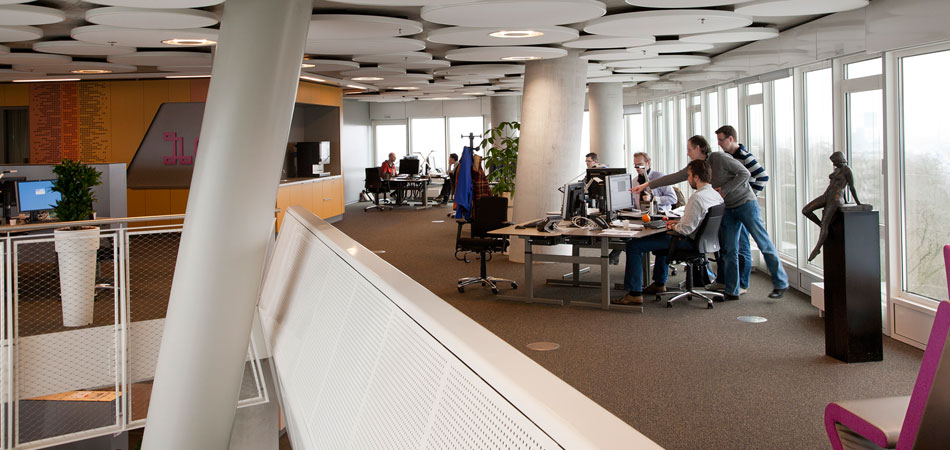
First, make an architecture or interior-design independent contractor into an employee by formalizing the person’s work arrangement and paying him or her regular wages. The IRS and its interpretation of payment and work plays the most important role in deciding a person’s status. At our staffing firm for architects and designers converting a independent contractor to a full-time employee is a third of our business.
Characteristics of an independent contractor
The IRS views an independent contractor as a person who works apart from the firm, and the rules governing them are not extremely clear cut. This wide room for interpretation has led to disputes in a number of workplaces. Fortunately, the status of an independent contractor is not as ambiguous as that of intern architect or draftsman.
By definition, an independent contractor is a person who has a significant amount of control over his or her work, achieves goals independently from the firm, doesn’t need to adhere to all the firm’s rules, uses his or her own equipment and doesn’t require close supervision by a member of the firm.
Characteristics of an employee
An employee must follow the set rules of the firm. He or she receives payment through a W-2 rather than a 1099 form. An employee uses the firm’s equipment to complete jobs, has a title with the firm and is subject to supervision by a member of the firm.
The transformation from contractors into employees
4 Key Points
- A person’s status changes when the firm takes them under its wing. Typically, this process involves the following aspects: training, giving the person authority to make decisions for the business, assigning the person key duties to perform and redefining the person’s work status as permanent, off-probation or retained for a set period of time. The process is complete when the new employee understands their work responsibilities and begins a project on behalf of the firm.
- It is critical that the person understand what it means when he or she has become an agent of the firm. The best way to accomplish this task is in writing. The new architect or interior designer and the owner of the firm should sign a letter of agreement stating the worker is now an employee.
- You can ratify and celebrate the change in a person’s status by providing them with business cards that state their title and contact information. Having a letter signed and dated by the owner that contains a start date is also helpful and thoughtful for those changing from independent contractors into employees.
- Finally, it is meaningful for the firm to circulate an internal announcement that they have hired the independent contractor as a full-time employee.
Source list:
http://www.cons4arch.com/
http://www.aia.org/akr/Resources/Documents/AIAB095064
https://www.mbopartners.com/resources/article/what-is-independent-consulting

Hiring Millennials
Consulting For Architects, Inc. is gathering editorial information from our architecture and design colleagues between the ages of 18 to 35. Your comments will be considered and may be quoted in our 2016 white paper: Hiring Trends – Millennials in the architecture workplace
Existing research on Millennials, by others claim:
- Seem to have shorter attention spans than Gen X or Boomers
- Tend to learn as much as they can, as quickly as they can, and then move on
- Trending towards smaller firms
- Seek firms compatible with their world view
Do you agree, disagree, or hold a different opinion? Can you identify what factors would influence your job hunting strategy?
We look forward to your comments.
You may also be interested in ranking the top 6 reasons millennials change firms by clicking on our survey.
Thank you for your time.
Hiring Millennials
|
architects, architectural design, architecture, Consulting For Architects, Employment, Hiring, job hunting, job interview, jobs, Millennials, unemployed architects
|

Video Interviews
Top 5 Reasons to try video interviews?
1. Reduces your carbon footprint.
2. Reduces traveling to multiple interviews.
3. Embraces new innovations and technologies.
4. Presents you as a person, not a piece of paper.
5. Employers (9 out of 10) watch video resumes before reading paper resumes. Clients frequently submit their own questions for you.
The benefits of embracing video interviews for the environment are easy to see, but it’s also great at cutting down wasted time in your career search. Think of how tough it can be to schedule interviews at the best firms. Now imagine how easy it could be if the firm could meet you virtually from anywhere, at any time. Best of all, the environment gets a reprieve.
Video Interviews Help Staffing Firms Become More Successful
Staffing firms are a collection of professional Talent Acquisition professionals. But their lives could be made so much easier with video interviews. Many staffing firms employ Talent Acquisition specialists who often find they lack enough time in the day to complete every task, or who become exasperated trying to track candidates down. Using video interviews, staffing firms can help their Talent Acquisition team get their lives back. Find out how:
• Video interviews save staffing firms time. When it comes to finding the right candidate, it’s up to their Talent Acquisition team to source and screen hundreds of candidates for just the right fit. Often, this is done by building talent pools from which to read through matching resumes. Then comes the old phone screen. This can be a cumbersome process. A phone screen could take an hour per employee. However, many staffing firms are increasingly finding that by using video interviews, they’re able to screen more candidates in less time. Imagine the Talent Acquisition pros being able to sit back and collect video interviews on demand from candidates. This means less time trying to track candidates down and schedule formal phone screens. Instead, they can send an email with a link that candidates log onto to prepare their video on demand. Suddenly, staffing firms are able to put the onus on candidates. They can simply sit back and wait for a candidate to record their video interview on demand and send it to the Talent Acquisition professional. Staffing firms, are able to view 10 video interviews on demand in the span of time it takes to do one phone screen.
• Collaboration is enhanced with video interviews. Often, the Talent Acquisition pros in staffing firms feel as if they’re operating in a bit of a vacuum. We’ve heard from many staffing industry pros that they find a great candidate they’d like to share, but it can be difficult to break through the noise of candidate resumes flowing in and collaborate. This can be a frustration of the past. With video interviews, staffing firms are able to view, score and share the top video interviews with their colleagues. This brings more eyes into the process and ensures a better candidate screening overall.
• Video interviews enhance the candidate experience. Of the thousands of candidates we work with per month, we hear a common frustration: their candidate experience is lacking. When candidates apply to jobs through staffing firms, they can feel like little more than a number. Video interviews can help make them feel like they’re going through a personal experience. Live video interviews are a great way for candidates to log on, view welcome videos, and to gain more information on the position they’re applying for. This allows Talent Acquisition to offer more nuance to the candidate. And using the visual medium, it allows them to tell their client’s story better. Candidates love video interviews because they feel it’s more intimate than walking in and finding 10 other candidates also competing for the same position. Video interviews are technologically advanced and offer candidates an immersive experience, allowing both Talent Acquisition and candidates to tell their story better.
- Time to hire shrinks with video interviews. These days, candidates want a shorter time to hire. According to the Bureau of Labor Statistics, time to hire rose from 24.5 days to 29 days in July of 2015. This is due in part to rising hiring quotas and shrinking budgets to actually accomplish increased hiring requirements. As the Baby Boomer generation begins to retire and employers increasingly look to the Millennial generation to fill these roles, time to hire will become increasingly important. Approximately 33% of Millennials report that they get hired within a month’s time. Longer times to hire could potentially scare away the very best candidates.Staffing firms are finding themselves increasingly in demand because of the roaring return of the economy. As more jobs are added to the job market, their Talent Acquisition teams will find themselves struggling to keep up. With video interviews, they can remain ahead of the curve and deliver superior results to their customers. Interested in finding out more? Call us today and schedule a free demo of our video interview software.
The Job Hunt
|
architects, architecture, business, Candidates, Employment, Freelancers, hiring an architect, Job Interviews, jobs, Resumes, unemployed architects, Video Interview
|
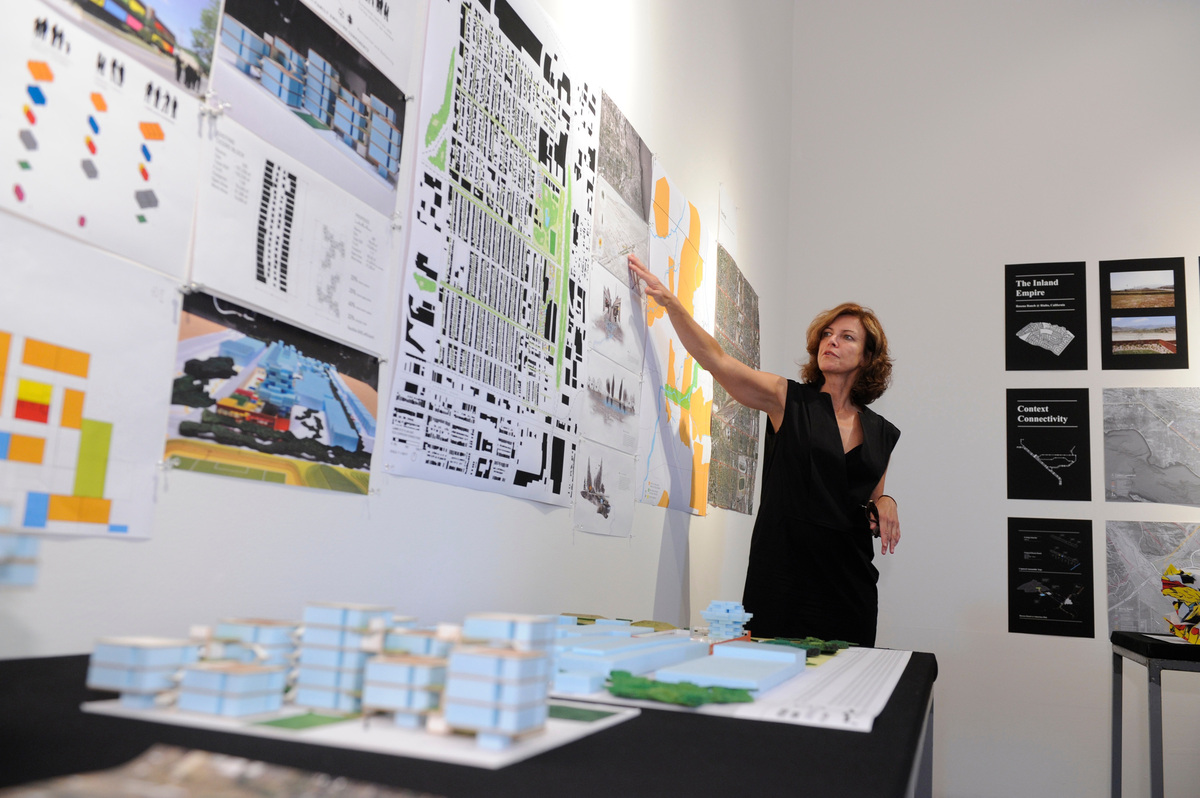
The Growing “Gig Economy”
There has been a lot of debate over the past year about the merits of the gig economy—where people work on a project or contract basis instead of holding down jobs as traditional full-time employees. Presidential candidates have weighed in on the pluses and minuses of “gig” or contingent work. Lawsuits against on-demand work companies like Uber and Handy are widely covered in the press while investors continue to pour billions of dollars into similar startups.
For the most part, these discussions and debates have focused on companies like Uber and Lyft that connect independent contractors with customers to provide consumer services. More often ignored is the growing population of contingent workers, including independent contractors, statement-of-work-based labor, and freelancers who provide services to corporations. But this is a growing population of workers, many of whom are highly skilled.
It takes a careful mix of mission, management, and culture.
Attracting, retaining, and managing these highly skilled workers will require new ways of thinking about talent management and the role that external talent plays. Companies will need to become “the client of choice” for these high-end contractors.
Recent research illustrates the growing corporate use of contingent workers:
Our own research reinforces these findings. The MBO Partners 2015 State of Independence workforce study found that 6.4 million Americans report that they provide professional services to corporations on a contingent or contract basis. Of these, about 2 million report earning $75,000 or more last year.
Not only is this group large—by way of comparison, this is substantially more than the roughly 4 million Americans who work in the automotive industry, including those working in car dealerships and automotive parts retailing—it’s also growing. Our study shows the number of contingent workers providing professional services to corporations has been growing at about three times the rate of overall employment over the past five years.
Two broad shifts—one on the employer side, the other on the worker side—are driving this boom. First, companies increasingly need a flexible workforce to compete globally. In our research we heard from company leaders that their businesses are turning to independent workers to increase business flexibility and agility. Independent workers allow them to quickly and efficiently scale staffing up and down to meet shifts in demand and changing business circumstances in an increasingly volatile and always-changing global economy. Businesses are also turning to highly skilled independent workers due to difficulties in attracting and retaining employees with hard-to-find specialized talents.
Second, many skilled professionals want independence and are going into contingent work to gain greater work/life flexibility, autonomy, and control over their careers. These highly talented professionals are realizing they are able to go off on their own and make as much or even more money — so they’re doing just that.
These professionals are in demand, and they know it. According to our research, 83% say they have a lot of choice or some choice over who they work with. Only 17% report having little or no choice over who they work with. In other words, these talented professionals can choose what to work on and with whom to work.
So what do these highly skilled independent workers want from their clients?
Being paid well and on time is obviously important to independent workers. But less obvious — and generally more important — are the non-monetary reasons independents choose their clients.
Skilled independents want the ability to control their lives, have meaningful work, and to be part of the team. When it comes to deciding which clients to work with, 96% selected “Value my work” as an important client attribute. Right behind was “Allow me control over my schedule” (89%) and “Allow me control over my work” (88%). “Treat me as part of the team” came in fourth. While independents value their autonomy and don’t want to be traditional employees, they also want to be treated as contributing team members.
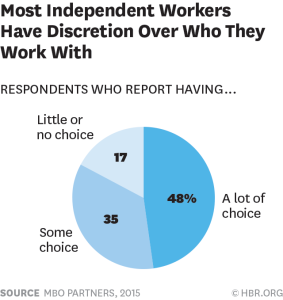
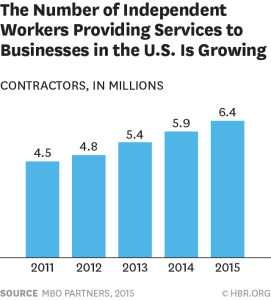
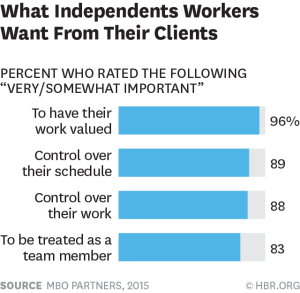
Co-Authored by:
Steve King is a Partner at Emergent Research, a research and consulting firm focused on small and micro businesses.
Gene Zaino is the founder and CEO of MBO Partners, a provider of support, tools and resources for independent professionals and their clients.
Original Source
Consulting Community
|
architects, business, Consulting, David McFadden, Employment, flex staffing, Flexible Workforce, Freelancers, Gig, Hiring, jobs, Project based
|

Architecture Billing Index
Architecture firms anticipate relatively slow adoption rates for new and emerging technologies in design and construction
| By Kermit Baker, Hon. AIA, AIA Chief Economist |
U.S. architecture firms reported another solid month of growth in October 2015. The AIA’s Architecture Billings Index (ABI) was 53.1 for the month, demonstrating a solid increase in firm billings that was just below the 53.7 score for September. New project inquiries, with a score of 58.5 for the month, and new design contracts at 51.7, point to healthy business conditions at architecture firms. However, both readings fell a bit from their September level, suggesting that growth may moderate just a bit in the coming months.
 Click to expand The overall strong performance in business activity in recent months is beginning to show a regional pattern. Firms in the South have been reporting continued strong business conditions through the year, while firms in the West have been reporting acceleration in billings over the past few months. In contrast, Northeast firms have been reporting weak conditions in recent months, and Midwest firms—while reporting growth—have seen billings increase at a somewhat slower pace.
Firms in all the major construction sectors reported healthy conditions in October, with the strongest growth coming from commercial/industrial firms. Residential firms recorded their second straight monthly increase after seven straight monthly declines. Institutional firms saw growth on par with September, but their ABI scores have been declining for the past several months, indicating that the pace of growth of billings at these firms has been moderating.
In Spite of International Concerns, U.S. Economy Doing Well
The economy sputtered a bit in the third quarter, producing only 1.5% growth at an annualized basis. However, there appears to be some firming in economic conditions to date in the fourth quarter. There was a net increase of 271,000 payroll positions nationally in October, well above expectations, and the strongest monthly increase so far this year. That pushed the national unemployment rate down to 5.0%, its lowest level since early 2008. The construction sector has been an important contributor to the employment front, adding 31,000 payroll positions for October and 159,000 through the first ten months of the year. Construction has thus accounted for almost 8% of payroll gains so far in 2015.
An improving labor market, coupled with continued low gasoline prices, has improved the consumer’s outlook. The preliminary consumer sentiment index from the University of Michigan jumped up in November to its highest level in several months. This has produced higher levels of consumer spending, as retail sales—after netting the lower amounts spent on gasoline—saw healthy gains in October. A key test of the perceived health of the economy will come in mid-December when the Federal Reserve Board decides whether an increase in short-term interest rates is warranted to prevent potential future overheating.
Innovative Technologies May Not Yet Be Ready For Prime Time
In the design professions, as in other sectors in our economy, change is inevitable, but the pace of change may be slower than commonly thought. In an effort to see how the profession might be evolving over the coming five to ten years, this month’s question to the AIA’s Work-on-the Boards panel looked at design and construction elements that might be increasing in importance over this time period.
Topics covered included the areas of design and construction process and techniques, building characteristics, building features and systems, and construction materials. Several of the areas deemed to be becoming more widespread over this period are already fairly widely utilized, such as lighting technology systems (LED, day lighting/natural light), water conservation/efficiency, and energy efficiency designs and retrofits. The overwhelming majority of respondents felt that these design elements would be increasing in importance over the coming five to ten years.
However, other recent innovations that typically have garnered more attention may not reach the same levels of adoption over this period according to architecture firms. One example is the use of robotics in the construction process. Only one in nine respondents feels that this technology will significantly increase in importance over the next five to ten years. Conversely, about four in ten respondents feel that there were be no significant increase in this technology over the coming years. The results were not much different for 3D printing used in the construction process. Only about one in six respondents feels that this technology will significantly increase in importance in the coming years.
This month, Work-on-the-Boards participants are saying:
• After a late summer lull, clients seem to be back at their desks, making decisions and issuing RFPs and RFQs. Prospects for 2016 are looking up.
—33-person firm in the West, mixed specialization
• Firms are very busy and fees are slowly catching up with personnel salary increases.
—6-person firm in the South, institutional specialization
• Northeast (other than NYC) is still struggling to come out of the recession.
—4-person firm in the Northeast, mixed specialization
• New problem for us, long-predicted: talent shortage. Could increase staff by 15-20% if people were available. I expect this to last a long time.
—20-person firm in the Midwest, commercial/industrial specialization
Additional Resources:
Join the AIA Practice Management Knowledge Community to receive more practice-related content
Reference:
The ABI Work-on-the-Boards Survey Panel is open to any AIA member who is principal/partner of their firm. Apply to join the ABI panel by completing a brief background information form on your firm here.
Article originally posted on the AIA.org Website. |
Architecture Practice
|
aia, architects, architecture, Architecture Billing Index, Consulting For Architects, David McFadden, design, Economics, Federal Reserve, Fees, Inc, Labor Market, Salaries, Talent Shortage
|

Assembling a City
Perkins Eastman designs a city on the former site of an Atlanta car factory
The City of Doraville, population 8,300, is a 15-mile drive from downtown Atlanta. The suburban enclave is also the last stop on Atlanta’s METRO Gold line rail transit system. Around the station, Stan Eckstut, principal at Perkins Eastman, has designed a “city-within-a-city” on the 165-acre site of a former General Motors assembly plant, adding a heavy dose of transit-oriented walkability that developers at The Integral Group hope can entice city-centric millennials to the city’s fringe.
“It is a city, there’s no question,” Eckstut said of the development, dubbed “Assembly, Doraville, USA.” His master plan design—a mix of about 50-percent public space and 50-percent developable land sandwiched between railroad tracks and an interstate highway—embraces density around the Doraville transit stop, connecting to the city’s historic downtown with an armature of parks that will guide development over the next decade.
Eckstut said streets and public spaces organize development parcels, which are envisioned as fluid land-use designations rather than prescribed uses—much like in a real city. In turn, market forces guide what ends up getting built. Eckstut cautioned against the pitfalls of large-scale “Renaissance plans,” that guided 20th century urban renewal, and today have influenced heavy-handed development in China. “The issue is creating something that can be implemented over time with many ideas and many innovations,” said Eckstut. “You need to focus on how it will get implemented and how you can create a fabric where things can evolve and change—much like the grid of Manhattan.”
Assembly sits on one side of a 30-foot-tall freight and transit rail line, one of the busiest in the Southeast, and Doraville on the other. Eckstut said connecting the two was important to create a real urban place. He plans to build a 60-foot-wide tunnel beneath 13 active tracks, an expensive feat, to create connections that can also foster density.
“The plans that preceded us all had bridges that went over the tracks,” said Eckstut. The massive approach ramps required for such a structure precluded creating a compact town center. “I realized I could bring a street right under the tracks and meet up with grade. That became the whole scheme.” Eckstut said the street—an extension of Doraville’s civic heart, Park Avenue—will form the framework for the rest of the development. “This is the glue that connects the historical town center with the new 165-acre site,” he said.
Just inside, an approximately 1.7-acre “Transit Square” serves as the forecourt to the larger parks system. From here, everything in Assembly is an easy walk. “I drew a circle with a radius of about 1,200 feet—a five minute walk,” said Eckstut. “When you reach a five-minute walk, the world changes—people don’t walk after that.” You can get just about anywhere in Assembly in five minutes, and your walk will always be close by a park.”
Eckstut said that Assembly’s park system is a sustainable machine for the entire neighborhood. “Most large-scale projects today have one major sustainability challenge: keeping stormwater on site,” he said. “The best way of doing that is creating a park system. Wherever you have streets, you’re going to have rain gardens.” Rather than build wide sidewalks, Eckstut hopes these gardens will create a more intimate and vibrant streetscape.
Eckstut said streets and public spaces organize development parcels, which are envisioned as fluid land-use designations rather than prescribed uses—much like in a real city. In turn, market forces guide what ends up getting built. Eckstut cautioned against the pitfalls of large-scale “Renaissance plans,” that guided 20th century urban renewal, and today have influenced heavy-handed development in China. “The issue is creating something that can be implemented over time with many ideas and many innovations,” said Eckstut. “You need to focus on how it will get implemented and how you can create a fabric where things can evolve and change—much like the grid of Manhattan.”
Assembly sits on one side of a 30-foot-tall freight and transit rail line, one of the busiest in the Southeast, and Doraville on the other. Eckstut said connecting the two was important to create a real urban place. He plans to build a 60-foot-wide tunnel beneath 13 active tracks, an expensive feat, to create connections that can also foster density.
“The plans that preceded us all had bridges that went over the tracks,” said Eckstut. The massive approach ramps required for such a structure precluded creating a compact town center. “I realized I could bring a street right under the tracks and meet up with grade. That became the whole scheme.” Eckstut said the street—an extension of Doraville’s civic heart, Park Avenue—will form the framework for the rest of the development. “This is the glue that connects the historical town center with the new 165-acre site,” he said. Perkins Eastman
The City of Doraville, population 8,300, is a 15-mile drive from downtown Atlanta. The suburban enclave is also the last stop on Atlanta’s METRO Gold line rail transit system. Around the station, Stan Eckstut, principal at Perkins Eastman, has designed a “city-within-a-city” on the 165-acre site of a former General Motors assembly plant, adding a heavy dose of transit-oriented walkability that developers at The Integral Group hope can entice city-centric millennials to the city’s fringe.
“It is a city, there’s no question,” Eckstut said of the development, dubbed “Assembly, Doraville, USA.” His master plan design—a mix of about 50-percent public space and 50-percent developable land sandwiched between railroad tracks and an interstate highway—embraces density around the Doraville transit stop, connecting to the city’s historic downtown with an armature of parks that will guide development over the next decade.

Everywhere within the Assembly development is a five-minute walk away.
Eckstut said streets and public spaces organize development parcels, which are envisioned as fluid land-use designations rather than prescribed uses—much like in a real city. In turn, market forces guide what ends up getting built. Eckstut cautioned against the pitfalls of large-scale “Renaissance plans,” that guided 20th century urban renewal, and today have influenced heavy-handed development in China. “The issue is creating something that can be implemented over time with many ideas and many innovations,” said Eckstut. “You need to focus on how it will get implemented and how you can create a fabric where things can evolve and change—much like the grid of Manhattan.”
Assembly sits on one side of a 30-foot-tall freight and transit rail line, one of the busiest in the Southeast, and Doraville on the other. Eckstut said connecting the two was important to create a real urban place. He plans to build a 60-foot-wide tunnel beneath 13 active tracks, an expensive feat, to create connections that can also foster density.
“The plans that preceded us all had bridges that went over the tracks,” said Eckstut. The massive approach ramps required for such a structure precluded creating a compact town center. “I realized I could bring a street right under the tracks and meet up with grade. That became the whole scheme.” Eckstut said the street—an extension of Doraville’s civic heart, Park Avenue—will form the framework for the rest of the development. “This is the glue that connects the historical town center with the new 165-acre site,” he said.
 |
|
 |
|
 |
|
The Yards will be the first portion of the plan built.
|
Just inside, an approximately 1.7-acre “Transit Square” serves as the forecourt to the larger parks system. From here, everything in Assembly is an easy walk. “I drew a circle with a radius of about 1,200 feet—a five minute walk,” said Eckstut. “When you reach a five-minute walk, the world changes—people don’t walk after that.” You can get just about anywhere in Assembly in five minutes, and your walk will always be close by a park.”
Eckstut said that Assembly’s park system is a sustainable machine for the entire neighborhood. “Most large-scale projects today have one major sustainability challenge: keeping stormwater on site,” he said. “The best way of doing that is creating a park system. Wherever you have streets, you’re going to have rain gardens.” Rather than build wide sidewalks, Eckstut hopes these gardens will create a more intimate and vibrant streetscape.

Around the parks, the city has approved up to 10 million square feet of development governed by form-based codes that call for maintaining a street wall without setbacks for the first 60 feet of height. Eckstut said the tallest buildings around the Transit Square will top out at up to 15 stories, as dictated by the airspace requirements of an adjacent airport.
The first section of the plan to be built is called “The Yards” on the southwest corner of the site, where a spur of the rail line once entered the factory. Eckstut convinced developers to save leftover remnants from the old GM plant to be repurposed as a film studio. Perkins Eastman is also designing a new minimalist loft building with an industrial aesthetic adjacent to the studio. Cottage-like outbuildings will surround the studio and additional offices will fill train cars. Developers plan on breaking ground on The Yards within the next year.
With the master plan complete and approved, each of six distinct neighborhood districts will go through a separate site planning process that goes into more detail about buildings and public space design. The district surrounding Transit Square and including the new underpass will go into planning in the next 18 months. Eckstut said this phase “is very complicated because we have to engage the transit station and the street that goes under. It involves at least a dozen entities.”
Architectural Design
|
architects, Architects Newspaper, architecture, Atlanta Car Factory, design, development, Doraville, Manhattan, METRO Gold line rail transit system, Millennials, Stan Eckstuk
|

World Wide Group is selling six buildings across the street from Bloomingdale’s. The new owner can raze the properties and build a 1,000-foot-tall residential tower.
Super tall tower – An ultra-pricey, tall residential tower could soon sprout across the street from Bloomingdale’s.
Real estate investment firm World Wide Group has put a collection of six, low-rise buildings near the corner of East 60th Street and Lexington Avenue on the market for sale. One of the properties was the longtime home of famed dive bar Subway Inn, which recently relocated. The site can accommodate a roughly 280,000-square-foot tower that could potentially rise as high as 1,000 feet. If a developer opts to include affordable housing, the square footage and height of the building would be permitted to increase by up to 20% more.
World Wide purchased the buildings one by one during the past decade. It has hired a team from Cushman & Wakefield—led by Bob Knakal, Cushman’s chairman of New York investment sales, and brokers Clint Olsen and Helen Hwang—to handle the deal. The site could be worth $300 million or more, a price that would make it one of the city’s most expensive ever sold per square foot.
Spanning six contiguous buildings from 143 E. 60th St. to 161 E. 60th St., the development site is across the street from Bloomingdale’s flagship department store and near a bustling shopping corridor on Lexington Avenue. Part of the site’s value is the 200 feet of frontage along East 60th Street that would allow a builder to create significant retail space.
If a tower is erected on the site, it would be one of few to reach the heavens on the far east side of midtown. Several 1,000-foot-plus developments are already underway farther west, just south of Central Park.
The site sale is one of the latest large assignments that is being handled by Mr. Knakal since he sold the brokerage firm he co-founded, Massey Knakal, to Cushman earlier this year. Mr. Knakal was tapped to handle the sale of 1 Court Square, the soaring office building in Long Island City, Queens, that is asking more than $500 million.
By Daniel Geiger
Photo: PropertyShark.com
Real Estate Developent
|
1 Court Square, affordable housing, architects, architecture, Cushman & Wakefield, Massey Knaka, New York investment sales, skyscraper, skyscrapers, Super, super tall buildings, Tall Buildings, World Wide Group
|


























